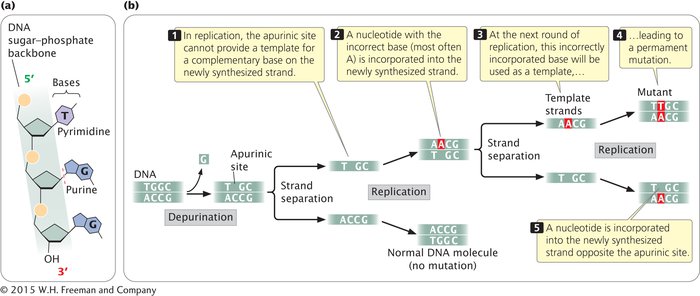Spontaneous Chemical Changes
In addition to spontaneous mutations that arise in replication, mutations also result from spontaneous chemical changes in DNA. One such change is depurination, the loss of a purine base from a nucleotide. Depurination results when the covalent bond connecting the purine to the 1′-carbon atom of the deoxyribose sugar breaks (Figure 13.14a), producing an apurinic site, a nucleotide that lacks its purine base. An apurinic site cannot act as a template for a complementary base in replication. In the absence of base-

Another spontaneously occurring chemical change that takes place in DNA is deamination, the loss of an amino group (NH2) from a base. Deamination may be spontaneous or may be induced by mutagenic chemicals.
Deamination can alter the pairing properties of a base: the deamination of cytosine, for example, produces uracil (Figure 13.15a), which pairs with adenine in replication. After another round of replication, the adenine will pair with thymine, creating a T • A pair in place of the original C • G pair (C • G → U • A → T • A); this chemical change is a transition mutation. This type of mutation is usually prevented by enzymes that remove uracil whenever it is found in DNA. Their ability to recognize the product of cytosine deamination may explain why thymine, not uracil, is found in DNA. In mammals, including humans, some cytosine bases in DNA are naturally methylated and exist in the form of 5- TRY PROBLEM 20
TRY PROBLEM 20

357
CONCEPTS
Some mutations arise from spontaneous alterations in DNA structure, such as depurination and deamination, which can alter the pairing properties of the bases and cause errors in subsequent rounds of replication.